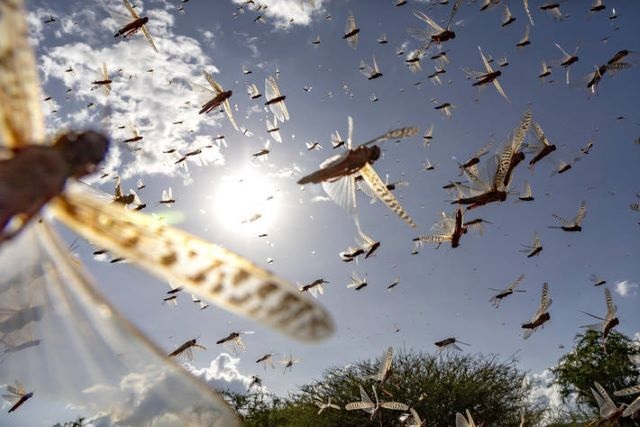
Kampala, Uganda | THE INDEPENDENT | Action to control unprecedented desert locust infestations in the Horn of Africa last year has protected crops and livelihoods, but funding is needed to sustain operations against new incursions, the Food and Agriculture Organization (FAO) said on Tuesday.
The UN agency is seeking USD 38 million to continue work in the region. Without this support, 28 aircraft that patrol the skies to spot and spray swarms could be grounded as early as March.
Dominique Burgeon, FAO’s Director of Emergencies and Resilience, said the huge desert locust swarms in 2020, some as wide as 60 kilometers, had not been seen in decades, threatening food security in a region where many were already going hungry. Surveillance and response led to 1.6 million hectares of land being treated. As a result, more than three million tonnes of cereals, valued at approximately USD 940 million, were protected: enough to feed 21 million people for a year.
“We can say that huge progress has been made, capacities of the countries have been tremendously augmented…but yet the situation is not over”, he told journalists, adding that although countries have made a huge effort, the region is much better prepared.”
Keith Cressman, FAO’s Senior Locust Forecasting Officer, said Cyclone Gati in December brought heavy rains, creating the conditions for new swarms to form in eastern Ethiopia and central Somalia. Locusts began migrating south to northern Kenya and southern Ethiopia when the waters dried up, as experts had predicted.
The agency reports that although neighbouring Kenya is heavily threatened, there were no locusts in Uganda by December 2020 and forecasts a low risk that a few small swarms from adjacent areas of Kenya could reach Karamoja.
“We had forecasted this in October. We had provided early warning to both countries to expect this shortly after mid-December, and that’s indeed what happened”, he said. “And since then, they have been arriving nearly every day.” The locusts are young now but will mature, and reproduce, in the coming months.
Pius Wakabi Kasajja, the Permanent Secretary in the Ministry of Agriculture, Animal Industry and Fisheries (MAAIF) says that although people underestimated the locusts because of the invisible damage in Uganda, many farmers would have lost out, if the migratory hoppers had not been managed.
“We deployed surveillance teams in advance after seeing the damage locusts had caused in Kenya. With the support of the Uganda People’s Defense Forces, we successfully assessed the travelling patterns of the swarm and constructed maps of sites where they laid eggs. That greatly helped us to make informed decisions while spraying the locusts, particularly the eggs before they could hatch” He said in the Ministry’s end of year report. He added that although Uganda was able to successfully overcome the threat of locusts, it is still keeping tabs on the affected areas.
FAO anticipates a new generation will emerge in early April, coinciding with seasonal rains and the planting period in Kenya and southern Ethiopia. Desert locusts are also breeding further north, on Somalia’s coastline on the Gulf of Aden, with new swarms likely to begin forming in late February.
********
URN
 The Independent Uganda: You get the Truth we Pay the Price
The Independent Uganda: You get the Truth we Pay the Price


